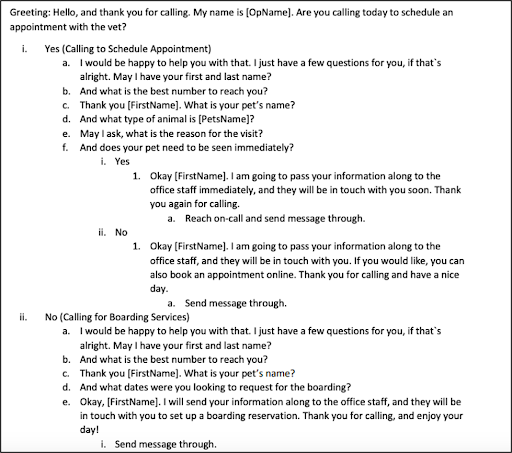![How to Build a Budget for Call Center Services [With Template]](https://img.shgstatic.com/clutch-static-prod/image/resize/715x400/s3fs-public/article/ba3fb126c373d45b88403b0272fa9201.jpg)
![How to Build a Budget for Call Center Services [With Template]](https://img.shgstatic.com/clutch-static-prod/image/resize/715x400/s3fs-public/article/ba3fb126c373d45b88403b0272fa9201.jpg)
Updated December 16, 2024
When a customer calls, your call center representatives need to be ready. Follow these call center training tips to ensure a positive customer experience.
Imagine calling customer service because you have a question about a bill, and getting routed to the wrong department. Or being disconnected. Or simply not reaching someone who can answer your question.
I bet you would be frustrated.
Looking for a Call Centers agency?
Compare our list of top Call Centers companies near you
For some, it might be reason enough to switch to a new service provider or to buy a product from a competitor in the future.
Poor customer service can negatively impact their brand image and can influence buying decisions. In fact, a Microsoft report on customer service disclosed that 96% of respondents said that customer support is a major factor in creating brand loyalty.
Consequently, how call centers handle customer interactions can have a massive impact on a company’s brand image and future sales.
As a representative of your business, and therefore, an extension of your brand, you need to ensure that new call center agents are onboarded properly.
You can help your new agents prepare by creating a comprehensive call center training program for your business. Here’s what they need to learn in a training session to provide a great customer experience.
5 Call Center Training Tips
Does your business need to outsource their call center? Find top call centers on Clutch.
A good answering service should provide a seamless experience for your customers, so when they call, they think that they’re speaking to an internal representative, rather than an agent.
For this to happen, your new customer service team needs to be fluent in your business’ style and voice.
Your business probably already has a brand style guide that outlines everything from color schemes and logos, to marketing collateral and language. Similarly, you need to create a guide for your virtual receptionists that outlines your brands’ tone, character, purpose, and language.
As an example, some businesses call their customers “clients,” while other call them “members.” Both evoke different feelings when it comes to your business, and you probably have already decided what your company prefers, so don’t forget to include that when you’re onboarding your voice services partner.
If you work in the financial industry, you might need a more professional tone, while a retailer can get away with something more casual.
You can establish a brand voice simply by outlining how you want your agents to greet your customers.
“Good morning, thanks for calling! My name is Margaret—what can I do to help you today?” can be very different than “Thanks for calling Clutch, we appreciate your call. How can I help you?”
Although they’re asking the same thing, the first greeting is more personal and casual, while the second is what customers might expect from a more formal institution.
Personalizing your service can help you build trust and loyalty with your customers. You can use this as an opportunity to continue to establish your brand.
For example, if Kathy Johnson calls your company, would you prefer that your agents call her Kathy, or more professionally, Ms. Johnson?
Either way, addressing your customers by name can humanize the customer-business interaction, and help foster a stronger connection with your business.
While noting the details of your brand, keep in mind that a professional service is more likely to use more complex sentences with industry-specific language, while a casual tone is usually indicated with simple sentences and is more likely to use slang.
Common phrases like, “Give me a second to check on that,” can be made more formal simply by asking, “Do you mind if I put you on hold?”
Determine what best represents your business and your brand, and stick to that. Just keep it upbeat and friendly.
Finally, your agents should know the ins and outs of your business. According to Microsoft’s report, knowledgeable agents are more important than ever.
Often callers contact support when they can’t address issues themselves or find the information online.
The same survey reported, “When a customer encounters a service issue that self-service can’t resolve, they continue to rely on live agents to deliver a knowledgeable, effective solution. Providing an effortless experience with seamless transitions between self-service and the agent-assisted experience will lead to more impactful customer engagement and long-term customer loyalty.”
Able to smooth out the customer service process, you need to keep your representatives informed on the products and services that your business provides. Well-informed, they can relay that information to your customers.
While it’s easy to give them a simple run down of what they need to know, you can grow their understanding by partnering them with a seasoned product specialist.
An internal team member can help onboard your answering service agents by easily addressing questions and guiding the process until the team can manage on their own.
As a result, your agents will be more helpful and provide your customers with better service. Over time, this will result in even stronger customer loyalty.
Answering questions or resolving issues quickly is key to keeping waiting times short and keeping customers happy. By operating efficiently, call centers can minimize hold times, demonstrating their respect for their customers’ time.
One way to keep call waiting times short is by knowing what to expect from calls. By outlining FAQs and common problems, call center employees will be more prepared to provide support.
To determine what customers struggle with most often, call centers should track the questions they’re asked most frequently. Then, they can create cheat sheets and or plans to address those issues.
Then, the call center will be able to incorporate these FAQs into their employee training.
Although answering services usually provide extensive customer service training for their agents, templates and scripts ensure that key information is portrayed when your customers call.
More importantly, these scripts help your agents know exactly what they need to do to keep the call short, sweet, and productive. This can help avoid bumbling and make your agents seem more informed
To get started, write your brand-consistent greeting at the top of the page. Then, list bullet points for the possible reasons why your customer is calling.
From there, you should include simple directives, and step-by-step directions of what your agent needs to ask your customer, or what they should do.
For a veterinary hospital, a final call center script might look something like this:

Source
This example outlines the questions that your virtual receptionist needs to ask, and the key information that needs to be recorded. After asking if the caller is trying to schedule an appointment for their pet, they can easily jump down to the next step based on the answer.
It’s important while writing your script to use an active voice and strong verbs, so everything is communicated efficiently and clearly.
Keep in mind that you should also avoid:
By following these guidelines, companies can create a call center script that reflects the brand well and enhances the customer experience.
While a lot of training for call centers focuses on hard skills such as technical onboarding, being able to relate to callers is an important part of the job.
As such, working on soft skills such as problem solving and communication can be what sets a call center apart.
In this environment, where it’s common to be talking to aggressive, irate, or frustrated callers, call center agents must practice emotional intelligence. Practicing how to recognize callers’ feelings and how to regulate their own is essential to ensuring that a call is productive.
By responding with empathy, communicating clearly, and managing stress, call center employees seem more authentic. To do this, they must practice going off-script when necessary, asking questions to get to the root of the problem, and providing personal anecdotes to show that they relate to their customers.
One way to do this is to practice reflective listening, a strategy that helps confirm the purpose of a call. For example, here is how one customer service representative could respond to a difficult customer:
Customer: “It took two weeks for me to get my order, and it’s the completely wrong product! I’ve been on hold forever — is this how you treat all your customers?!”
Representative Response: “I’m sorry you had to wait. From my understanding, you need to exchange the product you received with something different or return it for a refund. Is that correct?”
Call centers should practice reflective listening and adapting to callers’ needs through role play and shadowing.
These e-learning call center programs and learning management systems (LMS) can help with call center training.
A contact center can help you improve your customer support considerably by expanding service. Over time, this can result in stronger customer loyalty.
As an extension of your company, it’s important to take the time to provide your agents with the resources they need to onboard successfully. A guide that includes scripts, brand guidelines, and information on your business can help them provide better support for your customers.
By offering excellent customer service, a call center can help your business retain customers. It may even help you attract new clients who hear about their positive experiences.
![How to Build a Budget for Call Center Services [With Template]](https://img.shgstatic.com/clutch-static-prod/image/resize/715x400/s3fs-public/article/ba3fb126c373d45b88403b0272fa9201.jpg)

